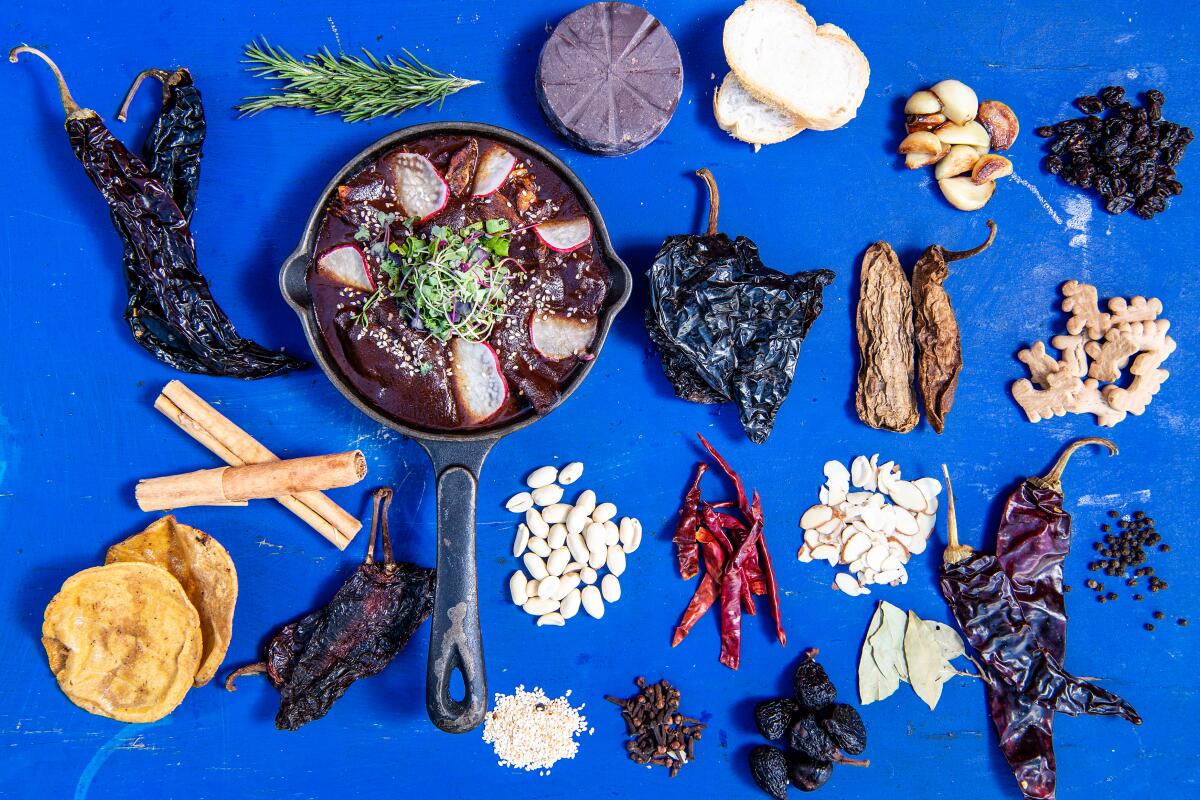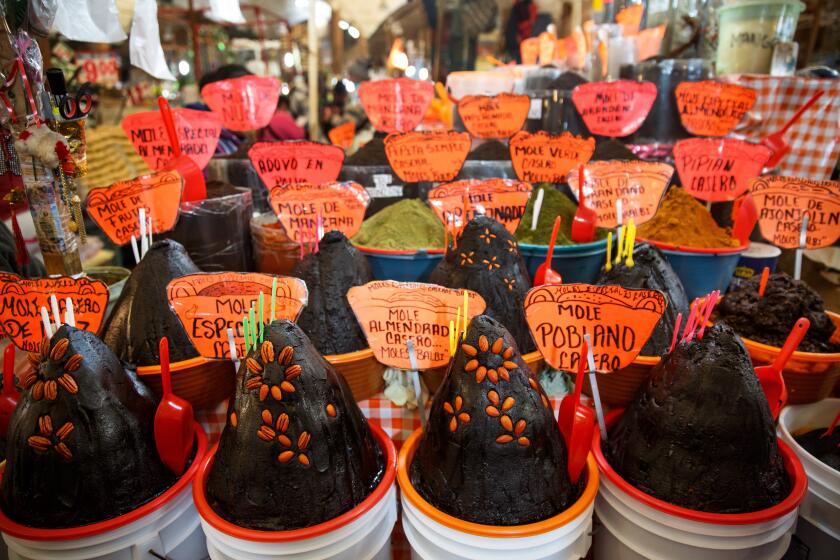Figs make this mole recipe uniquely Los Angeles

- Share via
Mole’s layered flavors come from first bringing out the best in each ingredient on its own, then blending and simmering them in a balanced, smooth, silky sauce.
Complicated as it may seem — and there are a lot of steps — you can nail mole on the first try without stressing if you break it down into its components and understand how they all come together. First, steep a stock of herbs, spices and Mexican chocolate; then toast and fry each component; then bring it all together.
Making mole from scratch is traditionally a large-batch, multiday project — something most of us don’t have time to regularly tackle. That’s where premade pastes come into play.
The recipe that follows is adapted from Christy Lujan of CaCao Mexicatessen. Dried Black Mission figs lend a deep red wine-like sweetness to a mole Poblano-style base. Lujan had three tips to help the new-to-mole cook:
- Good cooking takes time and effort. You need to deeply brown each ingredient individually: Dry-toast the nuts, seeds, dried fruit and crackers; blister the dried chiles; and fry the onion, garlic, tortilla and bread. Let each cook to deep brown, but don’t let any blacken. The dark burnish brings deep savory notes, but even a hint of burn will make the whole mole bitter. The ingredients have to be prepped one at a time because they toast at different rates; they also must be watched carefully because they go from toasty to charred quickly. Later, you need to strain the sauce, which is a pain but necessary to achieve the silkiest texture.
- Be bold in the kitchen. Lujan says the step where you pour the sauce into smoking hot oil is crucial, as it melds the flavors of the disparate ingredients by searing them together. Yes, it’s scary: It crackles as loudly as fireworks, spatters hard and may cause burns if you’re not careful. Put on an old long-sleeve shirt and an apron, stand back and pour with confidence. Then turn off the fire as fast as you can.
- Trust yourself. You can — and should — adjust mole’s seasonings to your taste. The recipe is calibrated to have a certain mix of spicy, salty and sweet, but you have to trust your taste buds to make it perfect for you. If it’s too spicy, toast or fry more crackers, tortilla or onion, then puree with water until smooth and blend into the sauce to mellow it. If it’s not spicy enough, do the same with chiles. Salt it more if you’d like or, if it’s too salty, thin it with water.

Mission Fig Mole Sauce
4 ½ hours, largely unattended. Makes about 8 cups.
You can serve this sauce with shredded poached dark chicken meat or grilled eggplant slices, though it probably would make wet cardboard taste good. Simply heat some of the sauce thinned with chicken or vegetable stock or water to achieve a pourable consistency.
Simmered ingredients
- 2 dried bay leaves
- 1 canela stick
- 1 3/4 teaspoons whole allspice berries
- 1 ¼ teaspoons whole black peppercorns
- 1/2 teaspoon whole cloves
- 1 2-inch rosemary sprig
- 2 sprigs thyme
- 1 ounce Mexican chocolate, preferably La Soledad
Toasted ingredients
- 6 tablespoons unsalted peanuts
- 2 tablespoons raw almonds
- 6 tablespoons white sesame seeds
- ½ cup animal crackers, preferably Mexican animalitos
- 2 cups dried Black Mission figs
- ¼ cup raisins
- 1 teaspoon canola or vegetable oil
- 2 ½ ounces chile negro peppers (about 7), stems and seeds removed
- 2 ½ ounces dried ancho chiles (about 5), stems and seeds removed
- ¾ ounce dried pasilla de Oaxaca chiles or chipotle chiles with seeds (about 2), stems removed
- 2 tablespoons dried árbol chiles with seeds (about 8), stems removed
Fried ingredients
- 1 cup canola or vegetable oil
- 1 small white onion, coarsely chopped
- 8 large garlic cloves, peeled
- 1 day-old yellow corn tortilla
- ½ cup stale bread cubes
- 1 tablespoon plus 2 teaspoons kosher salt
Instructions
- Prepare the simmered ingredients: Combine the bay leaves, canela, allspice, peppercorns, cloves, rosemary, thyme and chocolate with 2 ½ cups cold water in a large pot. Bring to a simmer over medium heat, stirring to melt the chocolate and prevent it from scorching, then remove from the heat and let steep until ready to use.
- Meanwhile, prepare the toasted ingredients: Heat a large skillet over medium heat. Add the peanuts and toast, tossing continuously, until dark golden brown in spots, 2 to 3 minutes. Transfer to the pot. Repeat with the almonds, toasting for 1 to 2 minutes, then the sesame seeds, toasting for 1 to 2 minutes.
- Spread the animal crackers in the skillet and toast, turning occasionally, until dark brown in spots, 1 to 2 minutes. Transfer to the pot, then wipe the skillet clean. Add the figs, turning occasionally, until softened and blistered in spots, 2 to 3 minutes. Transfer to the pot. Repeat with the raisins, stirring for 1 minute. Rinse out the skillet to remove any residual sugar and wipe dry.
- Set the skillet over medium heat again and add the oil. When it shimmers, swirl to coat the bottom of the pan and add the negro chiles. Toast, turning often, until soft and paler in spots (don’t let them blacken), 2 to 3 minutes. Transfer to the pot. Repeat with the ancho, pasilla and árbol chiles, and keep the skillet on the stove.
- Prepare the fried ingredients: Fill the skillet with the oil. Heat over medium heat until shimmering. Add the onion and fry, stirring occasionally, until very dark brown, about 15 minutes. Use a spider or slotted spoon to transfer to the pot. Add the garlic to the oil and fry, turning occasionally, until deep golden, about 2 minutes. Transfer to the pot with the slotted spoon.
- Add the tortilla and fry, turning occasionally, until dark and crisp, 1 to 2 minutes. Use tongs to transfer to the pot. Repeat with the bread, frying until brown and crunchy like croutons, about 30 seconds. Add the salt to the pot after the bread goes in, along with 6 cups water and stir well to combine. Pour the frying oil through a fine-mesh sieve into a liquid measuring cup and reserve.
- Puree the mole: Working in batches, transfer the mole mixture to a blender and puree until smooth, scraping the bowl as needed. The spices and herbs may not break down completely, which is OK, because the sauce will be strained. Pour and push the puree through a fine-mesh sieve into a large bowl, pressing on the solids to extract as much sauce as possible.
- Fry the sauce: Pour the reserved strained canola oil into a large, deep stockpot and heat over medium-high heat until shimmering. Carefully and quickly pour in the mole sauce at arm’s length to avoid burning yourself. Immediately turn off the heat and let stand until the bubbling subsides. The oil and sauce will splatter violently; the hard-fried flavor is an important element of the sauce.
- Stir the sauce well and bring to a simmer over medium heat, stirring often. Reduce the heat to low and simmer, stirring often for the first 30 minutes, being careful to not let the mole scorch at the bottom of the pot. Taste the sauce and adjust the seasonings if needed. Continue simmering over low heat, stirring occasionally, for an additional 2 hours.
- Remove from the heat and let stand for 5 minutes. Skim off and discard any oil that has accumulated on the surface. Cool to warm for serving or to room temperature for storing. When ready to serve, thin the sauce with stock or water to a pourable consistency if needed. Fold in meat or vegetables.
Make ahead
The mole can be refrigerated in an airtight container for up to 3 weeks or frozen for up to 2 months.
Adapted from Christy Lujan.
More to Read
Eat your way across L.A.
Get our weekly Tasting Notes newsletter for reviews, news and more.
You may occasionally receive promotional content from the Los Angeles Times.












